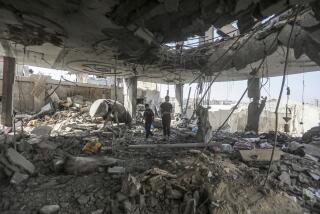U.S. Mistakenly Downs 2 Army Copters Over Iraq : Mideast: 15 of the 26 dead are Americans. Despite good visibility, F-15s target Blackhawks as Iraqi craft in ‘no fly’ zone. Pentagon is baffled. Clinton vows to ‘get the facts.’
Two U.S. jet fighters mistakenly shot down a pair of U.S. Army helicopters over northern Iraq early Thursday morning, killing 15 Americans and 11 foreign officials in an episode that left U.S. military officers baffled as to how the tragedy could have occurred.
U.S. officials said the helicopters, both Army UH-60 Blackhawks, were ferrying a team of foreign officers and Kurds on a routine visit to remote Kurdish villages. They said the pilots of the U.S. jets--both Air Force F-15C Eagles--somehow mistook the helicopters for Iraqi aircraft despite good visibility.
President Clinton expressed “deep sorrow” over the tragedy and pledged to “get the facts” to the American people and to U.S. allies.
The downing of the helicopters occurred despite elaborate procedures established by the military to prevent such misidentifications.
All four aircraft were under the control of an Airborne Warning and Control System (AWACS) command plane, and the pilots had rehearsed their duties. Blackhawk helicopters also normally are equipped with electronic devices that identify them to friendly aircraft.
Although Pentagon officials declined to describe current rules of engagement--for fear of compromising military security--experts said the jet pilots probably were required to receive the approval of AWACS controllers and to identify the aircraft visually before opening fire.
Although indications were that the pilots had fulfilled both conditions, analysts suggested that either the pilots had made a mistake in identifying the aircraft or had spoken to a different controller aboard the AWACS than had the helicopter pilots.
The incident was all the more startling because the area where it happened--the “no fly” zone from which Iraqi aircraft are excluded under terms set by the allies at the end of the Persian Gulf War--has been quiet for more than a year. The last time a U.S. plane shot at an Iraqi aircraft over the region was in December, 1992, when a U.S. F-16 shot down a Soviet-made MIG fighter.
In Thursday’s action, both of the Blackhawk helicopters were downed by U.S. missiles. One of the F-15Cs used a radar-guided AMRAAM missile, while the other used a Sidewinder, which homes in on the heat from its target--in this instance, the helicopter’s engine.
U.S. officials said that an American search-and-rescue mission recovered all 26 bodies, and the U.S. European Command, which oversees allied air operations in the region, is dispatching a team of high-level investigators to the crash site today.
Pentagon officials did not hide their bewilderment over how the tragic mistake had occurred.
“Clearly something went wrong,” Gen. John M. Shalikashvili, chairman of the Joint Chiefs of Staff, told reporters at a briefing.
Apart from the human tragedy, the episode was a setback for the military, which has been enforcing a “no fly” zone in the region for more than three years without major accidents.
The zone, established by the United States and its allies in April, 1991, was set up to protect Kurds in northern Iraq from raids by Iraqi troops. Iraqi aircraft are prohibited from flying in the zone.
Thursday’s episode occurred in a barren region 35 miles north of Irbil, an Iraqi city near the Turkish border. U.S. military teams landed at the crash site later and were guarding it while the investigation was under way.
Military officials said there were no survivors. The recovered bodies were flown to a U.S. air base in Turkey. The Pentagon said the names of the dead will probably not be made public until today.
The 11 foreigners aboard who were killed consisted of two Britons, one Frenchman, three Turks and five Kurdish leaders. Most of the passengers apparently were military officers who were assigned to U.N. military and relief efforts for the Kurds.
Defense Secretary William J. Perry postponed a scheduled trip to South Korea today because of the incident.
Perry told the Public Broadcasting System’s “MacNeil-Lehrer News Hour” later that he had ordered interim changes in the procedures used to enforce the “no fly” zone that he said are designed to “minimize the risk” until the actual cause of the accident is known.
He said investigators will probably be able to piece together a minute-by-minute account of the incident in a few days but warned that it could take longer to uncover the underlying problem. “It’s clear that there were some serious errors made,” the secretary said.
Army Lt. Gen. Richard F. Keller, chief of staff of the U.S. European Command, said it was not immediately clear whether the allies will continue their patrols without interruption.
But officials said later that the United States has no plans to abandon enforcement of the “no fly” zone, particularly in view of stepped-up harassment of the Kurds by Iraqi forces in the last few months.
Besides the “no fly” zone in the north, the allies have set up a similar flight ban in southern Iraq, this one to protect Shiite Muslims, who also have been the target of Iraqi attacks.
U.S. warplanes consistently have shot down Iraqi aircraft that have violated the “no fly” restrictions and have bombed Iraqi radar batteries that have targeted U.S. or allied jets while they were on patrol.
It was not immediately clear why the F-15C pilots mistook the U.S. Army helicopters for Iraqi aircraft.
Perry said the two F-15C pilots asserted in interviews later that they had positively identified the helicopters as Iraqi Hinds and even listed them that way in the reports that they filed after they landed.
Military officials said the Blackhawks can look something like Soviet-built Iraqi Hinds when equipped with extra fuel pods, as they were on Thursday, but that the two aircraft still have some distinguishing features.
Officials said the two helicopters had been flying below the F-15Cs and crashed about 220 yards apart. But they said they would be unable to provide other details, such as the altitude at which the four aircraft were flying, until sometime today or tomorrow.
In Incirlik, Turkey, where the F-15Cs are based, officials said that four of the allied officers killed were colonels, while the others were majors and lieutenant colonels. A U.S. political official may also have been aboard.
Serchil Qazzaz of the Patriotic Union of Kurdistan said that the officials had been scheduled to land in the town of Salahuddin for talks with leaders of the two primary Kurdish guerrilla groups in Iraq.
Witnesses described the crash site near the city of Irbil as a grisly scene littered with the charred remains of aircraft and bodies burned beyond recognition.
Kurdish officials said they initially believed that the helicopters had been shot down by Iraqis. Some said they could not believe that the pilots of the U.S. jet fighters could have mistaken the Blackhawk helicopters for Hinds.
Iraqi activity against the Kurds, which fell off for a while in 1992 and 1993, reportedly has intensified. Kurdish groups said earlier this week that they had arrested two Iraqi agents with orders to attack the few foreigners still helping Kurdish villagers.
The Pentagon said Thursday that it plans to ask military officials of Britain, France and Turkey to accompany its investigating team to examine the crash site.
Times special correspondent Hugh Pope in Istanbul, Turkey, contributed to this report.
Mistaken Identity
The Pentagon is investigating the downing of two U.S. Blackhawk helicopters by U.S. F-15C fighters enforcing the “no fly” zone over northern Iraq early Thursday morning. All 26 on board were killed when the fighters fired missiles at what they thought were Iraqi Hind helicopters.
The Fighters
The two U.S. F-15C fighters involved in the incident are based in Incirlik, Turkey.
How They Differ
The U.S.-made Blackhawk and the Soviet-made Hind helicopters have similar shapes, but there are distinctive differences between the two.
Blackhawk helicopter:
The Nose
Engine Air Intakes
External Fuel Tanks
Hind helicopter:
The Nose
Engine Air Intakes
Wingtip Weapon Mounts
Sources: Times wire reports, “Jane’s All the World’s Aircraft 1993-94”
Researched by DAVID F. MONTESINO / Los Angeles Times
The Danger Zone
The two U.S. helicopters downed by “friendly” U.S. fire were traveling in a “no-fly” zone in northern Iraq.
THE MISSION
The allies have been enforcing the “no fly” zone with some 70 U.S., British and French warplanes based at Incirlik in southern Turkey. The zone was set up by the allies to protect the Kurds from Iraqi vengeance for an ill-fated uprising after the Gulf War.
THE KURD REBELLION
The Kurds are seeking a separate nation, opposed by Iraq, Turkey and other nations where they have sizeable population. In March 1991, after half-century of failed rebellions against Baghdad, separatist Kurdish guerrillas rose and seized key towns. By April, Baghdad government crushed the rebellion.
THE U.N. EFFORT
The U.N. Security Council has demanded that Iraq end repression of all of its civilians and permit unimpeded delivery of humanitarian supplies. But that council demand was not part of the Gulf War cease-fire.
The United Nations carries out major humanitarian relief operations in the north. About 200 U.N. civilian police guards are deployed in the north to protect humanitarian aid workers there.
Accidental Deaths
Nearly 25% of the American deaths in the 1991 Persian Gulf War were attributed to “friendly fire.”
Number of U.S. troops killed by friendly fire: 35
Killed by enemy fire: 113
Worst Incidents
Jan. 29, 1991: Seven Marines die when missile hits vehicle.
Feb. 27, 1991: Six U.S. soldiers killed by tanks.
Iraq says zone a violates its sovereignty, adding that if the big powers can carve up a country at will, then the whole world is in danger.
Sources: Times Washington Bureau, Associated Press
More to Read
Start your day right
Sign up for Essential California for news, features and recommendations from the L.A. Times and beyond in your inbox six days a week.
You may occasionally receive promotional content from the Los Angeles Times.






